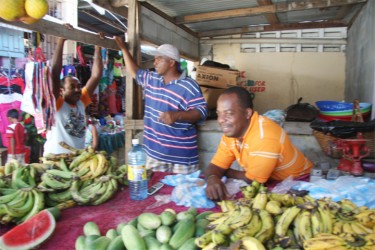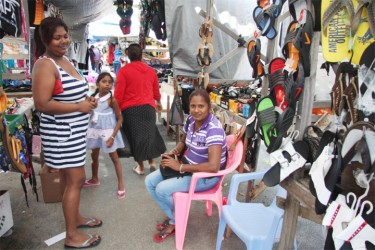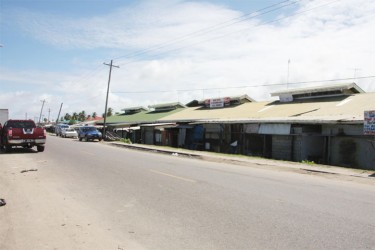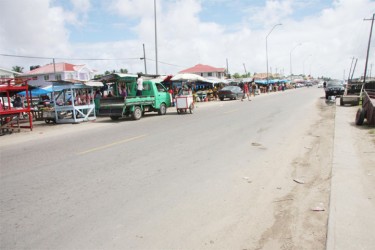The market at Mon Repos is one of several similar facilities along the East Coast Demerara highway or on the Railway Embankment road.
They are, for the most part, centres of both economic and cultural activity, serving as both meeting places and trading posts. Villages with resident markets tend to encourage various forms of economic activity including fishing, farming and small-scale manufacturing. The markets serve as outlets for what they produce. But the markets also do more; they attract sellers from far-flung communities seeking to ‘try their hands’ in another environment and buyers who leave their own communities to ‘check out’ bargains elsewhere.
The market at Mon Repos has a character of its own. It comprises a building that accommodates

around 400 stalls and a strip of tarmac on the opposite side of the East Coast Highway at Mon Repos where a further 200-odd stalls are located.
The building is a somewhat foreboding structure. Inside, it appears run down. It could be much better lit and the ground underfoot is uneven. It is not the sort of place in which you can take as leisurely stroll. The vendors at local markets are never without a slew of complaints about run-down or substandard facilities.
The western end of Mon Repos market is marginally more habitable. The stalls offer mostly hardware goods and clothing and appear better managed than those at the other end.
On Saturday, some of the vendors seemed in the mood to complain. The proximity of the washrooms to the stalls from where they trade along with the stench emitting therefrom is discomfiting and poses a health hazard. They want something done about it.
The eastern and middle sections of the market where fish, fruit, vegetables and groceries are offered for sale are the busier sections. Parts of that area are completely exposed and during rainy periods are decidedly inhospitable.

The state of the facility provides a timely reminder that, on the whole, local markets are mostly in a condition of chronic neglect and that remedial action is by no means the first thing on the ‘to do’ lists. That is a pity. Better-appointed markets can enhance the communities in which they are located in several significant ways.
Opposite the structure the open-air market on the tarmac thrives. The outside is decidedly more appealing.
Conversations with the vendors inside give the sense of a thinly-veiled ‘feeling’ between them and their counterparts trading on the tarmac. The problem appears to stem from the fact that some vendors have stalls both inside and outside the market so that apart from benefiting from what one might call ‘two bites of the cherry’ those with dual stalls are accused of causing business on the inside to shrink. It is not a raging row, more an issue for ongoing discourse.
Trading on the tarmac occurs on Saturdays, Sundays and holidays. The items on offer range from poultry meat to musical compact disks. Sellers come from Georgetown, the Canal Polders on the West Demerara and from villages along the East Coast. Buyers too come from far and wide. The Mon Repos tarmac is widely considered to be one of the better trading spots among weekend markets on the East Coast.
Across the country, market days have their unique rituals. At Mon Repos, the vendors chat animatedly while they trade. The fact that they are competing for the same customers does not appear to undermine the sense of camaraderie they share. Sometimes the human congestion and the traffic bring a few officers from the neighbouring BV Police Station.
There is a leisurely air about the market environment. People are in no hurry to leave and the crowds and the congestion remain for a while.

Market vending is often a step away from paid employment and towards entrepreneurship. Cecelia used to be a teacher. Ten years ago she left her job and began selling cosmetics in the market. Up until last year she was “doing well”. Then there was a drop in sales of around 20 per cent. She attributes this to more aggressive competition. More than that, the cost of transporting her goods to and from Better Hope and porterage—$3,500—add significantly to the cost of her outlay. There are days when a trip to the market leaves her out of pocket.
Close by, brother and sister team, Vinood and Hemwattie Sewsankar are selling shoes and clothing. They have been doing so for the past ten years. They say that 2013 was “a good year”. It appears that they were able to attract regular customers. They are currently preparing for Mashramani. Clothing vendors inside the market are less upbeat about their sales. The advantage which they feel the vendors ‘on the outside’ have, has become a bone of contention since the tarmac was built about five years ago.The fish stalls inside the market are usually the first to be deserted. Fish is usually a good seller and there is no competition from the tarmac outside.
On Saturday, the post-Christmas prices for fruit and vegetables appeared reasonable. Cabbage could be had at $160 per pound and both tomatoes and eschalot (scallions) at $200. A head of lettuce was being sold for $100. Eddo appeared to be selling well at $100 per pound while two pounds of cassava could be had for $100 and plantains were $100 to $140 per pound. Meanwhile the vendors were offering four boulanger for $200, squash for $160 each, a generous slice of pumpkin for $180, pepper at $200 a pint, and ochro at $140 to $200 a pound.
Some of the retailers—like Leon Benjamin—were complaining about having to compete with wholesalers.

Benjamin and his family sell fruits and vegetables at Mon Repos. He is a native of Pomeroon, but now lives at Parfait Harmonie. Last year was “a bad year” for him. “It was so bad that I was unable to save any money,” he said. He buys plantain and ground provision from the Farmers Market at Stabroek Market. He, too, is concerned about the competition from the wholesalers who go to Mon Repos. For him, trading has become stressful but he has no option. He must leave home early in the mornings to get to the market by 6 o’clock.
Lakeram (Prov Man) also sells ground provision on the tarmac. He also believes that the trade is becoming increasingly competitive. Last year, including the Christmas season, was a difficult period for Prov Man. He believes the consumer demand along the East Coast has been negatively affected by the problems facing the sugar industry. Apparently, the wives of sugar workers have been among the market’s best customers. Times, however, are changing.
Talking with both vendors and customers at Mon Repos you get a sense of quiet resignation to difficult times. They reflect rather than complain and after you have listened to them for a while you get a feeling that the sense of affluence that is sometimes reflected elsewhere in the country is still to reach poor communities where the vagaries of an economy that favours some much more than others remain a matter of concern.
Prov Man has learnt to live with the ebb and flow. He recounts endless stories of ordinary consumers who have learnt to live in their making-ends-meet economies. One such was of a customer who had only just paid him the $100 that had been outstanding for a pound of plantains taken on credit just before Christmas. On Saturday, other vendors and other shoppers had stories about last year’s economic disappointments. Some of them were still trying to sell imported fruit and confectionery left on their hands from the season that is now behind us. Others were contemplating where they would find money to stock their stalls to begin the new year. The shoppers had gone to the market with light wallets in search of bargains that were mostly non-existent.
Large quantities of meat – chicken, duck, beef and mutton – are traded at the Mon Repos market. The issue of sanitation on the tarmac arises. The bits of discarded meat pose an obvious health hazard; the sight and smell of it notwithstanding.
Within recent years the Neighbourhood Dem-ocratic Council has prohibited the slaughtering of poultry and animals on site. However, there appeared to be evidence that the practice persists.
Meat is one of the strong sellers at Mon Repos. Rafeek and Rohani, a husband and wife team, have been in the business for more than 20 years. They travel to Essequibo and Berbice to acquire their stocks. They said that consumers purchased less meat this Christmas.
On Saturday the prices for various meats were: duck, $700 per pound; mutton, $900 per pound; goat, $1,000 per pound; mutton, $900 to $1,000; and chicken $300. ‘Experts’ considered these prices to be marginally better than a few weeks earlier. The vendors on the tarmac at Mon Repos have another issue on their minds. Sooner or later they will be displaced to accommodate a new four-lane highway currently under construction. It does not appear as though they have received either reliable notification or information as to what the future of tarmac market will be. The uncertainty adds to an already existing condition of worry.




